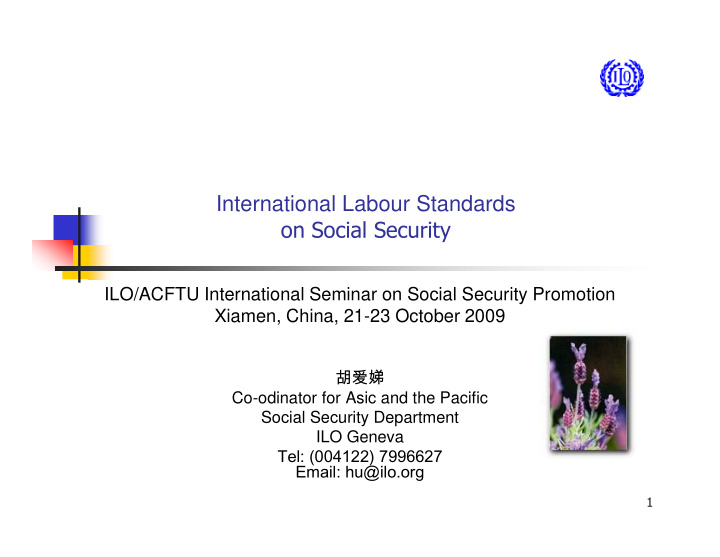



International Labour Standards ������������������ ILO/ACFTU International Seminar on Social Security Promotion Xiamen, China, 21-23 October 2009 胡爱娣 Co-odinator for Asic and the Pacific Social Security Department ILO Geneva Tel: (004122) 7996627 Email: hu@ilo.org �
����������������������������� 1. The forms of international labour standards 2. ILO’s up-to-date social security standards 2. ILO’s up-to-date social security standards 3. Main features of Convention No. 102 4. Number of countries having ratified Convention No. 102 �
1. The forms of international labour standards The ILO is the only international organization which is charged by its � constituents with the setting of international labour standards. International labour standards take the form of either Conventions or International labour standards take the form of either Conventions or � � Recommendations. Conventions are open to ratification and when ratified they, they � become legal obligations, if not ratified, they represent goals for national policy making. Recommendations a re not open to ratification, they provide technical � guidelines for the implementation of Conventions at national level. �
��������������������������������������������� � Conventions C. 102 on Social Security (Minimum Standards) � C. 121 on Employment Injury Benefits � C. 128 on Old-Age, Invalidity and Survivors’ Benefits C. 128 on Old-Age, Invalidity and Survivors’ Benefits � C. 130 on Medical Care Benefits � C. 168 on Unemployment Benefits � C. 183 on Maternity Benefits � C. 118 on Equality of Treatment in Social Security � C. 157 on Maintenance of Migrant Workers Rights � Major Recommendations � R. 67 on Income Security � R. 69 on Medical care � �
3. Main features of Convention No. 102: Basic principles It is based on commonly agreed social security principles, including the � followings: Guaranteed, defined benefits � Participation of protected persons in administration � General responsibility of the Governments for General responsibility of the Governments for � � sprovision of benefits, and � proper administration of schemes, e.g. through regular actuarial reviews Collective financing � Adjustment of pensions (long-term benefits) � Right of appeal � Equality of treatment � �
3. Main features of Convention No. 102: Nine branches Defines 9 branches of social security � Medical care benefit � sickness benefit � unemployment benefit unemployment benefit � old-age benefit � employment injury benefits � maternity benefit � family benefit � invalidity benefit � survivors’ benefit � �
3. Main features of Convention No. 102: Minimum standards for the nine branches Defines 9 branches of social security � Minimum percentage of personal coverage � Minimum level of benefits � Miximum qualifying period for the entitlement to benefits � Minimum duration of benefits � �
���!�!������������������"��#���$� Minimum C. No. 102 C. No. 102 C. No. 102 C. No. 102 Standards Branches Benefit Conditions Duration of Benefit Coverage of persons 50% of all employees or 20% of all residents, or all Sickness Benefit 45 % To preclude abuse 26 weeks (each case residents whose means do not exceed certain limits sickness) 50% of all employees, or all residents whose means do Unemployment Benefit 45 % To preclude abuse 13 weeks in period of 12 months not exceed certain limits 50% of all employees or 20% of all residents, or all Old-Age Benefit 40 % 30 years Throughout the contingency residents whose means do not exceed certain limits Employment Injury Benefits Short term disability 50 % No qualifying Throughout the contingency 50% of all employees, and their widows and children in Permanent disability 50 % period allowed case of death of the breadwinner through an employment injury Death of the breadwinner 45 % 50% of all employees or 20% of all residents, or all Family Benefit 3% or 1,5% To preclude abuse Throughout the contingency residents whose means do not exceed certain limits Women of classes of employees constituting not less than Maternity Benefit 45 % T o preclude abuse Minimum of 12 weeks 50% of all employees or 20% of all residents, 50% of all employees or 20% of all residents, or all Invalidity Benefit 40 % 15 years Throughout the contingency or until residents whose means do not exceed certain limits old – age pension is paid % Wives and children of 50% of all employees, or 20% of all residents, or Survivors ’ Benefit 40 % 15 years Throughout the contingency all resident wives and children whose means do not exceed limits
3. Main features of Convention No. 102: Flexibility It is built upon the basis that there is no right model for social security � and it reflects countries’ social and cultural values, their history, their institutions and their level of economic development. It thus includes several flexibility clauses to allow as many countries as � possible to fulfill its provisions. For instance: ratification of 3 out of the 9 branches � coverage of a certain percentage of worker or the population. � &
3. Main features of Convention No. 102: Application and compliance Social security schemes � Social insurance schemes � � With earnings-related components, or � Flat rate components, or � Combination of both Combination of both Universal schemes � Social assistance schemes � Social security administratio � Public social security schemes � Private social security schemes, if in compliance with minimum � standards and basic principles �$
����'�!"������������������(��)����������#���$�*� Ratification map (44 ratifications as of 2008) ��
4. Number of countries having ratified C. 102: Country list by year (cont.) Albania (2006) France (1974) Niger (1966) Austria (1969) Germany (1958) Norway (1954) Barbados (1972) Greece (1955) Peru ( 1961) Belgium (1959) Iceland ( 1961) Poland (2003) Bolivia (1977) Bolivia (1977) Ireland (1968) Ireland (1968) Portugal (1994) Portugal (1994) Bosnia and Israel (1955) Senegal (1962) Herzegovina (1993) Italy (1956) Serbia (2000) Bulgaria (2008) Japan (1976) Slovakia (1993) DR Congo (1987) Libya (1975) Slovenia (1992) Costa Rica (1972) Luxembourg (1964) Spain (1988) Croatia (1991) Macedonia (1991) Sweden (1953) Cyprus (1991) Mauritania (1968) Switzerland (1977) Czech Rep. (1993) Mexico (1961) Turkey (1975) Denmark (1955) Montenegro (2006) United Kingdom (1954) Ecuador (1974) Netherlands (1962) Venezuela (1982) ��
+���,����- ��
Recommend
More recommend